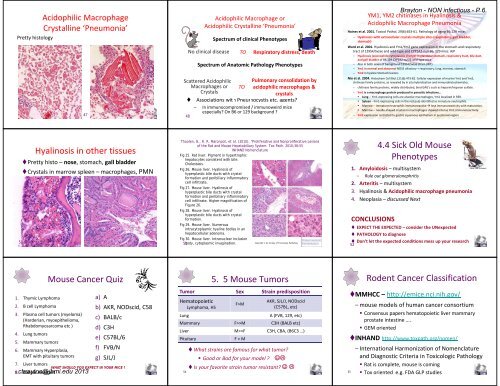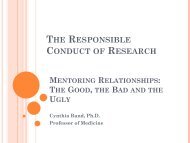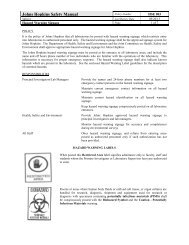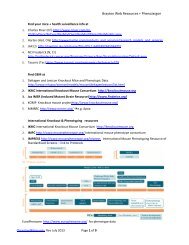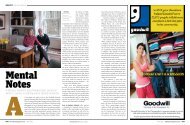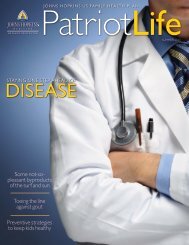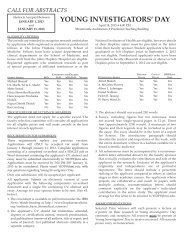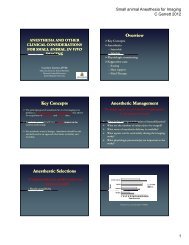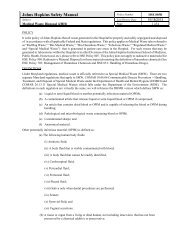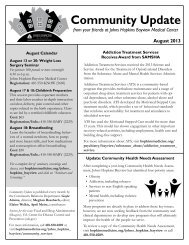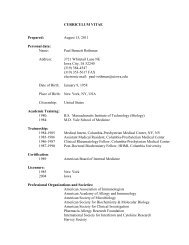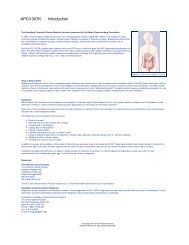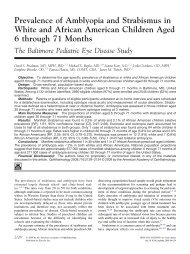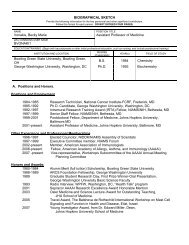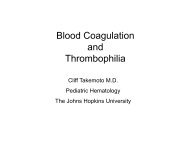Sick - Johns Hopkins Medicine
Sick - Johns Hopkins Medicine
Sick - Johns Hopkins Medicine
Create successful ePaper yourself
Turn your PDF publications into a flip-book with our unique Google optimized e-Paper software.
Pretty histology<br />
Acidophilic Macrophage<br />
Crystalline ‘Pneumonia’<br />
47<br />
Acidophilic Macrophage or<br />
Acidophilic Crystalline ‘Pneumonia’<br />
Spectrum of clinical Phenotypes<br />
No clinical disease TO Respiratory distress, death<br />
Spectrum of Anatomic Pathology Phenotypes<br />
Scattered Acidophilic<br />
Macrophages or<br />
Crystals<br />
TO<br />
Pulmonary consolidation by<br />
acidophilic macrophages &<br />
crystals<br />
Associations with Pneumocystis etc. agents?<br />
– In immunocompromised / immunoweird mice<br />
especially? On B6 or 129 background ?<br />
Brayton - NON infectious - P 6<br />
YM1, YM2 chitinases in Hyalinosis &<br />
Acidophilic Macrophage Pneumonia<br />
Haines et al. 2001. Toxicol Pathol. 29(6):653‐61. Pathology of aging B6;129 mice.<br />
– Hyalinosis with extracellular crystals multiple sites (respiratory, gall bladder,<br />
stomach)<br />
Ward et al. 2001. Hyalinosis and Ym1/Ym2 gene expression in the stomach and respiratory<br />
tract of 129S4/SvJae and wild‐type and CYP1A2‐null B6, 129 mice. AJP<br />
– Hyalinosis (eosinophilic cytoplasmic change) in glandular stomach, respiratory tract, bile duct,<br />
and gall bladder of B6,129 CYP1A2‐null & wild‐type mice<br />
– Also in both sexes of background 129S4/SvJae strain (WT)<br />
– Ym1 in normal and abnormal NOSE olfactory + respiratory, lung, marrow, stomach<br />
– Ym2 in hyaline Stomach lesions<br />
Nio et al. 2004. Histochem Cell Biol.121(6):473‐82. Cellular expression of murine Ym1 and Ym2,<br />
chitinase family proteins, as revealed by in situ hybridization and immunohistochemistry.<br />
– chitinase family proteins, widely distributed, bind GAG’s such as heparin/heparan sulfate.<br />
– Ym1 is a macrophage protein produced in parasitic infections…<br />
• Lung ‐‐ Ym1‐expressing cells are alveolar macrophages, Ym1 localized in RER.<br />
<br />
• Spleen ‐‐Ym1‐expressing cells in the red pulp identified as immature neutrophils.<br />
• Marrow ‐‐ immature neutrophils immunoreactive lose immunoreactivity with maturation.<br />
• Marrow ‐‐ needle‐shaped crystals in macrophages showed intense Ym1 immunoreactivity.<br />
48 – Ym2 expression restricted to gastric squamous 49 epithelium in junctional region<br />
Hyalinosis in other tissues<br />
Pretty histo – nose, stomach, gall bladder<br />
Crystals in marrow spleen – macrophages, PMN<br />
Thoolen, B., R. R. Maronpot, et al. (2010). "Proliferative and Nonproliferative Lesions<br />
of the Rat and Mouse Hepatobiliary System. Tox Path. 2010;38:5S<br />
INHAND Nomenclature<br />
Fig 25. Rat liver. Pigment in hypertrophic<br />
hepatocytes consistent with bile.<br />
Cholestasis.<br />
Fig 26. Mouse liver. Hyalinosis of<br />
hyperplastic bile ducts with crystal<br />
formation and peribiliary inflammatory<br />
cell infiltrate.<br />
Fig 27. Mouse liver. Hyalinosis of<br />
hyperplastic bile ducts with crystal<br />
formation and peribiliary inflammatory<br />
cell infiltrate. Higher magnification of<br />
Figure 26.<br />
Fig 28. Mouse liver. Hyalinosis of<br />
hyperplastic bile ducts with crystal<br />
formation.<br />
Fig 29. Mouse liver. Numerous<br />
intracytoplasmic hyaline bodies in an<br />
hepatocellular adenoma.<br />
Fig 30. Mouse liver. Intranuclear inclusion<br />
51 body, cytoplasmic invagination.<br />
50 Copyright © by Society of Toxicologic Pathology<br />
X<br />
4.4 <strong>Sick</strong> Old Mouse<br />
Phenotypes<br />
1. Amyloidosis – multisystem<br />
– Rule out glomerulonephritis<br />
2. Arteritis – multisystem<br />
3. Hyalinosis & Acidophilic macrophage pneumonia<br />
4. Neoplasia – discussed Next<br />
CONCLUSIONS<br />
EXPECT THE EXPECTED –consider the UNexpected<br />
PATHOLOGY to diagnose<br />
Don’t let the expected conditions mess up your research<br />
52<br />
X<br />
Mouse Cancer Quiz<br />
1. Thymic Lymphoma<br />
2. B cell Lymphoma<br />
3. Plasma cell tumors (myeloma)<br />
(Harderian, myoepithelioma,<br />
Rhabdomyosarcoma etc )<br />
4. Lung tumors<br />
5. Mammary tumors<br />
6. Mammary Hyperplasia,<br />
EMT with pituitary tumors<br />
7. Liver tumors<br />
8. Cancer resistant<br />
a) A<br />
b) AKR, NODscid, C58<br />
c) BALB/c<br />
d) C3H<br />
e) C57BL/6<br />
f) FVB/N<br />
g) SJL/J<br />
WHAT SHOULD YOU EXPECT IN YOUR MICE ?<br />
53<br />
cbrayton@jhmi.edu 2013<br />
X<br />
54<br />
5. 5 Mouse Tumors<br />
Tumor Sex Strain predisposition<br />
Hematopoietic<br />
Lymphoma, HS<br />
Lung<br />
F>M<br />
AKR, SJL/J, NODscid<br />
(C57BL, etc)<br />
A (FVB, 129, etc)<br />
Mammary F>>M C3H (BALB etc)<br />
Liver M>>F C3H, CBA, (B6C3 …)<br />
Pituitary<br />
F > M<br />
What strains are famous for what tumor?<br />
• Good or Bad for your model ? <br />
Is your favorite strain tumor resistant? <br />
Rodent Cancer Classification<br />
MMHCC – http://emice.nci.nih.gov/<br />
– mouse models of human cancer consortium<br />
• Consensus papers hematopoietic liver mammary<br />
prostate intestine ….<br />
• GEM oriented<br />
INHAND http://www.toxpath.org/nomen/<br />
– International Harmonization of Nomenclature<br />
and Diagnostic Criteria in Toxicologic Pathology<br />
• Rat is complete, mouse is coming<br />
• Tox oriented e.g. FDA GLP studies<br />
55


